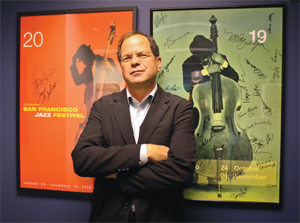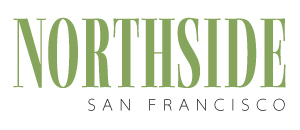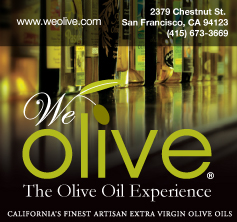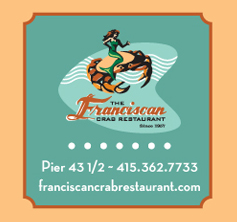
SFJAZZ founder Randall Kline
photo: Iris Rowlee
photo: Iris Rowlee
Tell us about the concept and intent of your new SFJAZZ Center.
It will be the first stand-alone jazz center in the western U.S. – a 35,000-square-foot building. It will feature a flexible concert hall seating from 300 to 700, a multipurpose facility with performance space to accommodate up to an 80-person audience, rehearsal rooms, a digital learning lab, a shop, box office, and administration space. It was designed by San Francisco architect Mark Cavagnero.
Is he a jazz fan?
He’s designed some marvelous structures in this area including an impressive music center in Mountain View. And when I looked up his website I found a John Coltrane quotation. So I was definitely going in the right direction.
In 2008 you told me, “Jazz is a great art form and deserves a major audience just as symphonic music or opera.” Can you expand on that?
We started in 1983 with the intent of creating an ongoing cultural entity. The National Endowment for the Arts wanted to bring jazz into the cultural mainstream. We were one of the beneficiaries of that thinking. It was a way to kick-start what was being called “America’s classical music.” That was a phrase being tossed around then. But I’m not sure I would describe jazz that way. It sounds stuffy to me.
Is it fair to say jazz is equal in cultural value to symphony or opera?
I would put it equal. But I’m aware there are those who believe jazz musicians may not be the equal of classically trained performers – an attitude that the training to be become an opera star is far more rigorous than that of a virtuoso jazz performer.
How do you feel about that?
I don’t think it’s that important. They are totally different. Artists at the top – whether brilliant classicists or brilliant jazz performers – are equal in my view. It’s the same as being a brilliant scientist or a brilliant writer. Once you’re at that level with incredible talent and the discipline that goes with it, artists are all the same. Is Duke Ellington’s work lesser somehow because it’s jazz? Duke’s work has lasting appeal. That’s the real test.
The London Observer stated that San Francisco provides “the biggest and best jazz festival in the world.” The New York Times seemed to agree but added the word “possibly.” Why is the San Francisco Jazz Festival world class?
Isn’t it wonderful that those publications hold that opinion? What we’re trying to do is present the best the world has to offer. We’re in a position to showcase that and we try to do it with great care. It’s the manifestation of our concept of jazz. We want to encourage new work and honor the old. That’s exciting and engaging. Jazz is vibrant. It speaks to anyone who listens.
Bobby Short once said, “San Franciscans open their ears. That’s what makes this festival so good. It’s highly adventurous and ambitious. It embraces many styles of music.” How do you come up with programming that’s adventurous and ambitious?
Our festival had adventurous programming in its DNA right from the start. My personal agenda was to open ears – to use Bobby Short’s expression. The truth is, it’s no great trick for me to program as I do. Good music is good music. Shouldn’t any performing arts organization try to reflect what’s actually happening now and not just what happened in the past? One of the great advantages we have is that we are able to react to the will of our audiences. People here have strong opinions. Why work against those opinions? I still get a naive thrill listening to new music.
How did you get this way?
I blame it on my parents. I grew up in a Massachusetts household that treasured music. My mother loved Broadway and movie show tunes and cast albums. She also appreciated symphony and opera. My father was more jazz oriented. He was a good amateur piano player. I grew up hearing Erroll Garner, Thelonious Monk, and other jazz artists. I also listened to pop. I was into the British invasion – the Beatles, the Rolling Stones, the Animals.
When did you have your jazz epiphany?
I dropped out of college back East and moved to the San Francisco Bay Area in 1975. I had applied to the Berklee School of Music in Boston and was accepted. My instrument was the stand-up bass. While I was preparing for Berklee I took a required class in ear training at College of Marin. I discovered the school had a great jazz tradition. There were teachers there who had studied with Stravinsky, Schoenberg and Milhaud, who worked in that idiom. In 1982 I entered San Francisco State University as a performance major instead of going to Berklee. Then in my senior year I decided to produce some jazz concerts and make some school money. I proceeded to lose every dollar I had. I dropped out of college for the second time and got a job at a club called the Boarding House here in the City. Then one thing led to another. And here I am.
When you listen for pure pleasure, what artists attract you the most?
I listen to many performers for pure pleasure. One who comes to mind instantly is Miles Davis. His 1960s quintet with Wayne Shorter on saxophone, Herbie Hancock on piano, Tony Williams on drums, and Ron Carter on bass, is something special to me. I also enjoy listening to that incredible pianist Brad Mehldau and saxophonist Miguel Zenon of our own special group, the SFJAZZ Collective. A favorite trumpet artist is Roy Hargrove. And of course, I always go back to people like Sonny Rollins on sax and Thelonious Monk on piano. There are many others, and I could go on here forever.
E-mail: ernest@northsidesf.com








